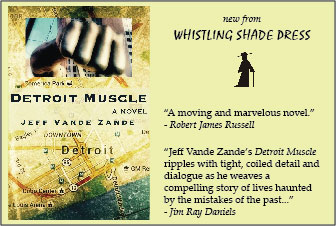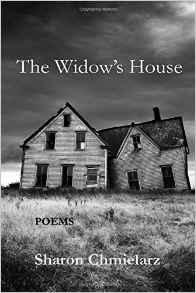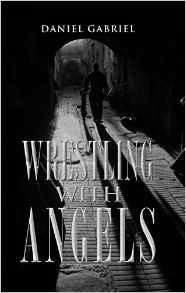


|

| <- Back to main page |
(Brighthorse Books)

A great loss is difficult to express, even in poetry. And so Sharon Chmielarz chooses rather to outline the boundaries of her grief in The Widow’s House, a collection of poems written after she lost her husband Tad. The book is a reflective pool of image and shadow, rising from memory and the wellspring of her always fecund imagination. Particular scenes are vividly depicted—eating Chinese take-out, flying on a plane seated next to each other, or (later) watching a black-and-white movie alone. Or, “At His Bedside”:
I bend down to him, head to head, my cheek
against his, clean, still sweet-
male smelling, all the dregs
of marriage drained away, only
after-ardor remains. And then the interloper
arrives, the third party he doesn’t fear, the lure that
sets his face alight, his
breath like a boy’s, running
in gasps, as if he can barely
believe the beauty of the girl who’s knocking at his door.
What is it like to live in the widow’s house? In the title poem, Chmielarz insists:
I wish my man
a good time.
In our
old way,
that earth way
But in “To Speak of” it is obvious that she is letting go of him unwillingly:
I search
calendars, clocks. Notebooks
become old outposts where I
may find news of him.
What a very Emily Dickinsonian way of putting it! Wading into the collection can seem, at times, like hiking a up a dark mountain—but The Widow’s House is not always gloomy. There are poems scattered here and there on such topics as a Jan van Eyck marriage portrait, a Grand Prix race held in 1908, and the curious “I Had to Go East to Get to My West”, where Chmielarz describes the interior of a rather mysterious house by the railroad tracks:
in autumn, the way shadows somedays
insist that furniture sway with them,
the way outside goodness seeps in
to heal a rough interior, a low interior
Is it too early to begin calling Sharon Chmielarz a Minnesota treasure? She’s written about Mozart, about Russia, about South Dakota prairie and Klezmer music, and even penned a children’s book or two. But The Widow’s House is probably Chmielarz’s most personal collection to date, and proof that, thank goodness, grief has not lessened the potent magic of her verse.
- Joel Van Valin
(New Rivers Press)
An alternate title for his this fiction collection might be The Two Sides of Daniel Gabriel, marrying as it does Gabriel’s traveler’s tales with more personal stories set in his native Minnesota. A life-long rocker, Gabriel sets the two genres apart in sections called “A-Side: Border Stories” and “B-Side: Shifting Gears”. And there is, like any great musical album, a “bonus track”.

The A-Side stories overdub Gabriel’s careful, subtly-crafted prose style with a hobo’s restlessness and flights of danger. “Unto Us, The Spoils” is a tale of skullduggery set in India where a couple of American con artists are outfoxed by a Bombay local. “The Man on the Train” is one of those border-crossing horror stories you hear about from travelers (in this case the nightmare country is Bulgaria), while “In the House of Mr. Poo” features an unwelcome foreign corpse and a much-put-upon host who is the very soul of inertia. “Dust to Dust” also contains a corpse, this time a drug overdose, but the tone is foreboding rather than playful, as a small group of foreigners become entangled by Afghanistan’s draconian justice system. There’s a weary Paul Bowles feel to the story:
An awning that had once been a sandy brown covered a small portion of the dust-strewn courtyard. Flies buzzed in its shade, licking at the sticky remains of tea and yogurt on the lone table beneath the awning, where a handful of travelers sat staring at the sudden burst of activity in the hotel.
And Gabriel channels Hemingway in the beautiful vignette “Sometimes”, especially the first line: “Sometimes he thought about the old days.” It’s a brief meditation in which a man walking by the riverside thinks about a similar scene when he was traveling with his wife and sons near Carcassonne years earlier. No further information is given on his current state of affairs, other than that his wife and boys are no longer with him. Both “Sometimes” and “The Road Goes Ever On” introduce us to that most evocative of travelers, the tramp. Though the latter story borrows its title from Tolkien, in content it’s Steinbeck all the way, with a young man meeting a bindle stiff while hitching a ride out to San Francisco.
The old man stood up and walked around the packs, holding his chest. He spat with difficulty. “The lifeline,” he said, pulling an invisible line behind him. “That’s what you’re holding when you know you’re going back—to a family ... or a job ... or anything at all.” He wiggled the imaginary line. “So long’s you’re dragging that, you’ll never be free. You see what I mean? It’s always got hold of you.” He looked at the boy—and then beyond. “Here’s a ride.”
The B-Side opens with three memoir-like stories surrounding Garbiel’s blind grandfather. “Jumping Off”, in which the boy guides the old man door to door selling knickknacks, serves as a good transition story, as it involves travel within the small sphere of a neighborhood. Music, strangely absent in a collection modeled after a record, begins to emerge later on the B-Side. “The Boots of Alfred Bettingdorf”, a coming-of-age story about a high-school outcast who dresses like the early Rolling Stones, is equal parts longing and swagger:
“Look at this.” He pulled out a magazine photo of the Stones: a full-length shot. “Look at those shoes,” he said. “You ever see anybody around here wear shoes like that?”
Richards wore boots. Scruffy, black, point-toed boots that disappeared up under his pants. Jagger had on what looked to be white hush puppies. Both were a far cry from the round-toed spit-shined wing tips that dominated our hallways.
“A Rocker’s Guide to the History of the Future”, a conversation held from a perspective of a future police state where radio is censored and rock banned, is more essay than story, while “The Devil Don’t Sleep ‘Til Sunrise” is a musical urban legend that Gabriel doesn’t quite pull off with authenticity. B-Sides are known for their novelties, and the final number, “By the Terebinths of Mamre”, a historical piece set in Old Testament times, certainly qualifies.
As for the bonus track—“DarkTime” is a sprawling, multi-faceted novella that gathers together themes of tramping, drug tripping, pagan magic and rock ‘n’ roll and distills them into a road tale set in the disheveled England of the 1970s. Layered with flashback and reminiscence, the most vivid scenes to me were at Glastonbury Tor, thought to be the Avalon of Arthurian legend. In a way “DarkTime” is not only a marriage of the two sides of Wrestling with Angels, but a call-out to Gabriel’s earlier books, the Welsh pub story collection Tales from the Tinker’s Dam and the spiritual thriller Twice a False Messiah.
All of which is why I highly recommend stopping by your favorite record store (uh, sorry, I mean book store) to grab a copy of Wrestling with Angels. Daniel Gabriel is a boundless and splendidly versatile writer, and I hope he will be laying down new tracks soon.
- Joel Van Valin 